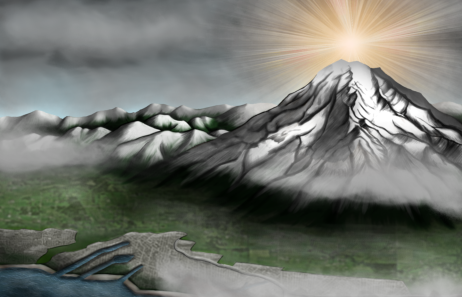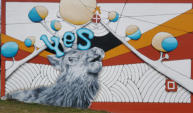

© 2019-’24 Cascadian Olympic Ventures, LLC
The astronomical winter solstice in the Pacific
Northwest, on December 21, welcomes the first day of
winter as well as a majestic blend of science, spirituality,
and tradition. Many may know winter solstice as the
shortest day of the year, and while they would be right,
this day also launches the “sun’s slow ascension back
toward those gloriously long and sunny days of summer.”
As the sun travels to “its lowest possible arc in the sky,” it
simultaneously signifies Earth’s closest proximity to the
sun at “high noon,” when the sun is directly overhead at
the latitude called the Tropic of Capricorn. It is at this
very moment in which those of us in the Puget Sound
region will receive yet another gift from Mother Nature.
Look toward Mount Tahoma (more commonly known as
Mount Rainier) and you will be captivated by a spectacular
vision of the sun rising behind her, almost as though the
peak of the mountain is bearing our brightest star.
In Tacoma, this reverent event is celebrated by way of a
wealth of amateur and professional photography, sacred
ceremonies in Fireman’s park, and commissioned works
of art such as that of artists Mindy Barker and Buster
Simpson. “Artist Mindy Barker’s mural (located on the
Cedar Rivers Clinics building at 14
th
and MLK) beautifully
captures the essence of the nearby spot where local
Indian tribes and their shamans gather on the Winter
Solstice each December 21
st
to share in the magic and
splendor of the sun rising over the top of Mt. Rainier. The
plaque (see section to right) marking the exact place
where the wise men assembled was a major creative
factor in her design; bringing forth the culture, beliefs,
and wisdom of both the indigenous and immigrant
peoples who have come to call Tacoma their home…(the
mural) recognizes the cycle of life on this earth…(and)
gives tribute to the majesty of Mt. Rainier itself (as well
as) declares the positivism of this place, Tacoma.”
While Tacoma pays tribute to the excellence that is winter
solstice and Mount Tahoma, many cultures and
communities around the world honor winter solstice as a
time for celebration of family, storytelling, and renewal. It
is a time in which we are meant to reflect on the past
year, come together with those we love, and awaken new
beginnings. The Wishtoyo Chumash Foundation describes
winter solstice as a time, “When we come together as
community to honor a new season…to reflect upon our
relationships with self, family, community and the natural
environment that sustains us all! How are we doing as a
Human Family? What steps can we take into the New
Cycle to deepen our relationships with each other, our
earth, ocean and all the living beings that exist here? Even
reflect on the connection of the ancestor stones whose
breath provides ancient wisdom if we care to listen.”
So, as the sun rises on December 21
st
at 7:54am and sets
at 4:20pm, listen. Listen and reflect. Listen, reflect, and
honor the wisdom of our ancestors, our cultures, and
that of Mount Tahoma, which reminds us on this day, at
“high noon,” to stand still and celebrate a renewal of
seasons, each other, and ourselves.

Mystery Plaque
On 19th and Market in downtown Tacoma, a small bronze plaque that is piece from a multi-part installation by artist Buster Simpson titled Parapet Relay resides with the suggestion, “Each December 21st gather to view the sun rise out of the top of Mount Rainier. If the weather cooperates when the first rays of daylight streak out of the peak of the sacred mountain, on this one day of the year, one can see through the spirit door between our world and the world of the dead.” The engraving also includes various indigenous names for Mount Rainier, such as Mount Tacoma and Mount Tahoma.
Cascadian Olympic Ventures, LLC
Tahoma Specialty Pest Services
1818 W. Francis Ave. #333
Spokane, Wa. 99205
509 978 7830
The Real Mt. Rainier


Tahoma Origins
“The Mountain is out!”
Those of us from the Pacific Northwest, specifically the Puget Sound region, know exactly what this
means. The majestic, snowcapped peak has emerged from the clouds to remind us of the surrounding
beauty of our setting and community. On a crisp and bright Washington day, the Mountain can and will
inspire awe, Tacoma pride, and a respect for her illustrious landscape. Though many of us are familiar with
the presence of the tallest mountain in the Cascade Range, we may not be as aware of her history,
specifically how she came to be known as Mount Rainier and the efforts to restore her name to Mount
Tahoma.
In 1792 the British explorer Captain George Vancouver claimed the discovery of and named Mount Rainier
after his friend, a fellow Englishmen and Royal Navy Rear Admiral, Peter Rainier, Jr. Though the people of
the Puyallup tribe populated the land and stewarded the resources of the sacred mountain, and though the
closest Rear Admiral Rainier had ever been to Washington was the east coast (to fight against the United
States in the American Revolution), the name has remained.
The anchored designation of Mount Rainier goes back to a centuries-long rivalry between Seattle and
Tacoma. In the 1890s, approximately 100 years after Captain Vancouver’s “discovery,” Washington State
U.S. Senator Watson C. Squire, also known as the largest landowner in King County, went to Washington
D.C. to encourage the National Geographic Board to make the name of the mountain officially Mount Rainier
and in 1899, Mount Rainier National Park was established.
Senator Squire’s actions were in response to Seattle and Tacoma fiercely fighting to become the western
terminus of the transcontinental railroad so that their city might be better connected with the rest of the
country and, consequently, bring more economic prosperity to their city. Tacoma won and in 1882 the
Northern Pacific Railroad Company began to refer to Mount Rainier as Mount Tacoma in its literature and
advertising. The city of Tacoma followed the lead of the Northern Pacific Railroad Company and for the next
40 years challenged the name of Mount Rainier in hopes of renaming the mountain Mount Tacoma. Knute
Berger, in his article “Why Mount Rainier Was Once Called Mount Tacoma,” shared more about the efforts of
the Tacoma community. “Decades of lobbying by Tacoma followed, mainly pushed not by the grassroots of
the city, but by its business boosters. They objected to the name of Mount Rainier National Park when it was
created. They lobbied newspaper editors across the country to support the name change. They went to the
state Legislature in Olympia. They demanded the Congress act. Hearings were held. The business
community formed a ‘Justice for the Mountain committee’ to push the cause.”
Given the economic investment and emotional attachment as well as the loyalty to the name of Mount
Rainier, the battle, of which still goes on today, was not easy and, in fact, University of Washington historian
John Findlay, who specializes in Pacific Northwest history, says “changing the mountain’s name would be
almost unimaginably difficult” because of the very reasons mentioned above. He goes on to state, “For the
mountain’s name to be officially changed, it must be approved by the Washington State Board on
Geographic Names, which works in cooperation with the U.S. Board on Geographic Names. The state board
relies heavily on community input. When controversy arises, the board tends to stay with the status quo.”
Still, though the “City of Destiny” ultimately lost, activists continue to speak out and advocate in hopes of
restoring the mountain’s identity. Cooper Weissman, a University of Puget Sound graduate and writer, urged
members of The Mountaineers in a 2017 essay, “The Case for Tahoma,” to take the historical words of an
original Mountaineer member, W.D. Lyman, also a former Professor of History and Political Science at
Whitman College, to heart and “act as allies to the tribes whose supreme mountain has been a gift to us all.”
Lyman pleaded in the inaugural Mountaineers newsletter in 1907, “Tacoma, or rather Tahoma, was the
Puyallup name from immemorial time, meaning, according to some, the mountain, the Supreme Mountain,
and according to others, the breast of the milk-white waters. We would venture to ask if it would not be a
fine thing for the Mountaineers to consider seriously an attempt to restore these beautiful and significant
native names thrust aside by the first explorers.”
In 2010, Puyallup tribal member Robert Satiacum proposed a name change as well. Actually, in Satiacum’s
words, a name “restoration.” However, unlike Weissman or Lyman, Satiacum has proposed to restore the
name to T’Swaq, meaning “the sky wiper.” Satiacum explains “Native people living in what is now the Pierce
County area were sometimes referred to as the Swaq people, because they lived in the shadow of the
sacred being.” The tribal member goes on to state “Long ago, according to ancient Salish legend, humans
used to walk hunched over. The sky was too low and didn’t leave room for people to stand upright. The holy
people got together, and decided the sky needed to be raised. So, they took their holy staffs, and stacked
one on top of the other, until they raised the sky to where it is today. The sky was placed on top of all the
mountains to rest. Because T’Swaq is the tallest mountain in the Cascade range, it’s shouldering the
heaviest weight. Where the clouds and the summits touch are holy places.” Satiacum said, “Reclaiming the
name of such a holy and majestic place, with such significance to his people’s culture and way of life, would
help Native people reclaim their identity and start a movement.”
This rich history shows that there is no doubt that the Mountain holds a grand significance within many
communities and cultures, which is why the debate about how she is known may well continue into the next
century. After all, as Berger notes, “Like Mount Rainier, the old volcano name controversy could erupt again
at any time.”
For links to resource articles, as well as website credits, please click here
.jpg)
.png)
Like what you’ve read? Consider supporting this page’s sponsor
Tahoma Specialty Pest Services
Tahoma Specialty Pest Services is a family owned and operated small
business in the Inland NW. TSPS provides expert pest & wildlife control,
utilizing the latest and best techniques to solve even the most difficult pest
problem. Rats, roaches, ants, bats, bed bugs, the list can go on, but the pests don’t
have to. No matter the pest problem, big or small, residential or commercial,
Tahoma Specialty Pest Services is the solutions provider for you.
Contact us today at: 509 978 7830


.png)

The Real Mt. Rainier


The astronomical winter solstice in the Pacific
Northwest, on December 21, welcomes the first day of
winter as well as a majestic blend of science, spirituality,
and tradition. Many may know winter solstice as the
shortest day of the year, and
while they would be right,
this day also launches the
“sun’s slow ascension back
toward those gloriously long
and sunny days of summer.” As
the sun travels to “its lowest
possible arc in the sky,” it
simultaneously signifies Earth’s
closest proximity to the sun at
“high noon,” when the sun is
directly overhead at the latitude
called the Tropic of Capricorn. It
is at this very moment in which
those of us in the Puget Sound
region will receive yet another
gift from Mother Nature. Look
toward Mount Tahoma (comm-
only known as Mount Rainier)
and you will be captivated by a
spectacular vision of the sun rising
behind her, almost as though the
peak of the mountain is bearing
our brightest star.
In Tacoma, this reverent event
is celebrated by way of a wealth
of amateur and professional
photography, sacred ceremonies
in Fireman’s park, and commissioned
works of art such as that of artists Mindy Barker and
Buster Simpson. “Artist Mindy Barker’s mural (located on
the Cedar Rivers Clinics building at 14
th
and MLK)
beautifully captures the essence of the nearby spot where
local Indian tribes and their shamans gather on the
Winter Solstice each December 21
st
to share in the magic
and splendor of the sun rising over the top of Mt. Rainier.
The plaque (see section to right) marking the exact place
where the wise men assembled was a major creative
factor in her design; bringing forth the culture, beliefs,
and wisdom of both the indigenous and immigrant
peoples who have come to call Tacoma their home…(the
mural) recognizes the cycle of life on this earth…(and)
gives tribute to the majesty of Mt. Rainier itself (as well
as) declares the positivism of this place, Tacoma.”
While Tacoma pays tribute to the excellence that is winter
solstice and Mount Tahoma, many cultures and
communities around the world honor winter solstice as a
time for celebration of family, storytelling, and renewal. It
is a time in which we are meant to reflect on the past
year, come together with those we love, and awaken new
beginnings. The Wishtoyo Chumash Foundation describes
winter solstice as a time, “When we come together as
community to honor a new season…to reflect upon our
relationships with self, family, community and the natural
environment that sustains us all! How are we doing as a
Human Family? What steps can we take into the New
Cycle to deepen our relationships with each other, our
earth, ocean and all the living beings that exist here? Even
reflect on the connection of the ancestor stones whose
breath provides ancient wisdom if we care to listen.”
So, as the sun rises on December 21
st
at 7:54am and sets
at 4:20pm, listen. Listen and reflect. Listen, reflect, and
honor the wisdom of our ancestors, our cultures, and
that of Mount Tahoma, which reminds us on this day, at
“high noon,” to stand still and celebrate a renewal of
seasons, each other, and ourselves.
“The Mountain is out!”
Those of us from the Pacific Northwest, specifically the Puget Sound
region, know exactly what this means. The majestic, snowcapped
peak has emerged from the clouds to remind us of the surrounding
beauty of our setting and community. On a crisp and bright
Washington day, the Mountain can and will inspire awe, Tacoma pride,
and a respect for her illustrious landscape. Though many of us are
familiar with the presence of the tallest mountain in the Cascade
Range, we may not be as aware of her history, specifically how she
came to be known as Mount Rainier and the efforts to restore her
name to Mount Tahoma.
In 1792 the British explorer Captain George Vancouver claimed the
discovery of and named Mount Rainier
after his friend, a fellow Englishmen and Royal Navy Rear Admiral,
Peter Rainier, Jr. Though the people of the Puyallup tribe populated the
land and stewarded the resources of the sacred mountain, and though
the closest Rear Admiral Rainier had ever been to Washington was the
east coast (to fight against the United States in the American Revolution),
the name has remained.
The anchored designation of Mount Rainier goes back to a
centuries-long rivalry between Seattle and Tacoma. In the 1890s,
approximately 100 years after Captain Vancouver’s “discovery,”
Washington State U.S. Senator Watson C. Squire, also known as the
largest landowner in King County, went to Washington D.C. to
encourage the National Geographic Board to make the name of the
mountain officially Mount Rainier and in 1899, Mount Rainier National
Park was established.
Senator Squire’s actions were in response to Seattle and Tacoma fiercely
fighting to become the western terminus of the transcontinental railroad
so that their city might be better connected with the rest of the country
and, consequently, bring more economic prosperity to their city. Tacoma
won and in 1882 the
Northern Pacific Railroad Company began to refer to Mount Rainier as
Mount Tacoma in its literature and advertising. The city of Tacoma
followed the lead of the Northern Pacific Railroad Company and for the
next 40 years challenged the name of Mount Rainier in hopes of
renaming the mountain Mount Tacoma. Knute Berger, in his article
“Why Mount Rainier Was Once Called Mount Tacoma,” shared more
about the efforts of the Tacoma community. “Decades of lobbying by
Tacoma followed, mainly pushed not by the grassroots of the city, but
by its business boosters. They objected to the name of Mount Rainier
National Park when it was created. They lobbied newspaper editors
across the country to support the name change. They went to the state
Legislature in Olympia. They demanded the Congress act. Hearings
were held. The business community formed a ‘Justice for the Mountain
committee’ to push the cause.”
Given the economic investment and emotional attachment as well as
the loyalty to the name of Mount Rainier, the battle, of which still goes
on today, was not easy and, in fact, University of Washington historian
John Findlay, who specializes in Pacific Northwest history, says
“changing the mountain’s name would be almost unimaginably difficult”
because of the very reasons mentioned above. He goes on to state,
“For the mountain’s name to be officially changed, it must be approved
by the Washington State Board on Geographic Names, which works in
cooperation with the U.S. Board on Geographic Names. The state board
relies heavily on community input. When controversy arises, the board
tends to stay with the status quo.”
Still, though the “City of Destiny” ultimately lost, activists continue to
speak out and advocate in hopes of restoring the mountain’s identity.
Cooper Weissman, a University of Puget Sound graduate and writer,
urged members of The Mountaineers in a 2017 essay, “The Case for
Tahoma,” to take the historical words of an original Mountaineer
member, W.D. Lyman, also a former Professor of History and Political
Science at Whitman College, to heart and “act as allies to the tribes
whose supreme mountain has been a gift to us all.” Lyman pleaded in
the inaugural Mountaineers newsletter in 1907, “Tacoma, or rather
Tahoma, was the Puyallup name from immemorial time, meaning,
according to some, the mountain, the Supreme Mountain, and according
to others, the breast of the milk-white waters. We would venture to ask
if it would not be a fine thing for the Mountaineers to consider seriously
an attempt to restore these beautiful and significant native names
thrust aside by the first explorers.”
In 2010, Puyallup tribal member Robert Satiacum proposed a name
change as well. Actually, in Satiacum’s words, a name “restoration.”
However, unlike Weissman or Lyman, Satiacum has proposed to restore
the name to T’Swaq, meaning “the sky wiper.” Satiacum explains
“Native people living in what is now the Pierce County area were
sometimes referred to as the Swaq people, because they lived in the
shadow of the sacred being.” The tribal member goes on to state
“Long ago, according to ancient Salish legend, humans used to walk
hunched over. The sky was too low and didn’t leave room for people to
stand upright. The holy people got together, and decided the sky
needed to be raised. So, they took their holy staffs,
and stacked one on top of the other, until they raised
the sky to where it is today. The sky was placed on top
of all the mountains to rest. Because T’Swaq is the tallest
mountain in the Cascade range, it’s shouldering the heaviest
weight.Where the clouds and the summits touch are holy
places.” Satiacum said, “Reclaiming the name of such a holy and
majestic place, with such significance to his people’s culture
and way of life, would help Native people reclaim their identity
and start a movement.”
This rich history shows that there is no doubt that the Mountain
holds a grand significance within many communities and
cultures, which is why the debate about how she is known
may well continue into the next century. After all, as Berger
notes, “Like Mount Rainier, the old volcano name controversy
could erupt again at any time.”
For links to resource articles, as well as website
credits, please click here
Tahoma Origins


© 2019-’24 Cascadian Olympic Ventures

Mystery Plaque
On 19th and Market in downtown Tacoma, a small bronze plaque that is piece from a multi-part installation by artist Buster Simpson titled Parapet Relay resides with the suggestion, “Each December 21st gather to view the sun rise out of the top of Mount Rainier. If the weather cooperates when the first rays of daylight streak out of the peak of the sacred mountain, on this one day of the year, one can see through the spirit door between our world and the world of the dead.” The engraving also includes various indigenous names for Mount Rainier, such as Mount Tacoma and Mount Tahoma..png)
Like what you’ve read? Consider supporting this page’s sponsor
Tahoma Specialty Pest Services
Tahoma Specialty Pest Services is a family owned and operated small
business in the Inland NW. TSPS provides expert pest & wildlife
control, utilizing the latest and best techniques to solve even the
most difficult pest problem. Rats, roaches, ants, bed bugs, the list
can go on, but the pests don’t have to. No matter the pest problem,
big or small, residential or commercial,
Tahoma Specialty Pest Services is the solutions provider for you.
Contact us today at: (509) 978 7830


Cascadian Olympic Ventures, LLC
Tahoma Specialty Pest Services
1818 W. Francis Ave. #333
Spokane, Wa. 99205
509 978 7830
























